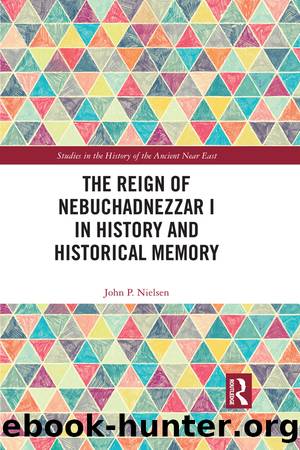The Reign of Nebuchadnezzar I in History and Historical Memory by John P. Nielsen

Author:John P. Nielsen [Nielsen, John P.]
Language: eng
Format: epub
Tags: History, Ancient, General
ISBN: 9781317300489
Google: lx9WDwAAQBAJ
Publisher: Routledge
Published: 2018-04-17T01:32:27+00:00
5.4.2 Reminding Babylon of Nebuchadnezzar I in the performative discourse
For those familiar with the traditions surrounding Marduk communicated in the Marduk Prophecy, the godâs entry into Babylon with Å amaÅ¡-Å¡umaukÄ«n in 668 and the rejoicing of the crowds along the processional way that led to Esagil would have been understood as reassuringly consistent with what was believed to have occurred in the past. Esarhaddon undoubtedly intended such a reception for either himself or his son when he began laying the groundwork for Mardukâs return. However, it is only certain that the scholarly elite at the city knew of the tradition that held that Marduk had departed and returned to Babylon as far back in the past as the early Kassite Dynasty. Presumably there would have been among their numbers assembled that day men who had engaged in the discourse that shaped Esarhaddonâs plans to return Marduk.
What is not known is how aware the common citizens of Babylon who witnessed the procession were of the traditions surrounding Marduk and the long-deceased kings such as Nebuchadnezzar I who had once led Marduk back into the city. However, given the shared aims of Esarhaddon and the Babylonian elite, it is possible to speculate on why and how some aspects of the Marduk tradition, including Nebuchadnezzar Iâs part in that tradition, could have been communicated to the populace. Among the throng of people assembled for Mardukâs return, there must have been those who possessed some knowledge of what had happened at Babylon in 689 through the communicative memory transmitted orally over the intervening three decades. It is even possible that there were some present who had witnessed the sack in their youths. Furthermore, it is reasonable to speculate that any animosity that the people of Babylon might have harbored toward Assyria was a concern for both Esarhaddon and the Babylonian elite. Esarhaddonâs half-brother, AÅ¡Å¡ur-nÄdin-Å¡umi, had been betrayed to the Elamites by the citizens of Babylon, and he would not have wanted his own son to suffer the same fate. Furthermore, by collaborating with Esarhaddonâs wishes to have Babylon rebuilt and Å amaÅ¡-Å¡uma-ukÄ«n installed as king, members of the Babylonian elite may have been viewed with resentment as Assyrian collaborators by factions opposed to Assyrian rule.103 For these reasons, it would also have been in the interest of Esarhaddon and pro-Esarhaddon Babylonians to present the coronation and return of Marduk as consistent with precedents from Babylonâs past.
The Marduk tradition had the potential to ameliorate these hostile sentiments, but communicating it to the populace would have posed challenges. Utilizing the written correspondence that was at the heart of the discourse between Esarhaddon and Assyrian and Babylonian scholars for this purpose would not have been feasible, so instead public acts and rituals must have been essential to the discourse between the king and the urban elites on one side and the illiterate population on the other. Esarhaddon had already used that approach when he and his sons participated in the basket-carrying ceremony during the rebuilding of the Esagil. As
Download
This site does not store any files on its server. We only index and link to content provided by other sites. Please contact the content providers to delete copyright contents if any and email us, we'll remove relevant links or contents immediately.
| Central Africa | East Africa |
| North Africa | Southern Africa |
| West Africa | Algeria |
| Egypt | Ethiopia |
| Kenya | Nigeria |
| South Africa | Sudan |
| Zimbabwe |
Goodbye Paradise(3729)
Men at Arms by Terry Pratchett(2784)
Tobruk by Peter Fitzsimons(2447)
Arabs by Eugene Rogan(2263)
Borders by unknow(2232)
Pirate Alley by Terry McKnight(2187)
Belonging by Unknown(1812)
It's Our Turn to Eat by Michela Wrong(1688)
The Biafra Story by Frederick Forsyth(1616)
Botswana--Culture Smart! by Michael Main(1559)
The Source by James A. Michener(1540)
A Winter in Arabia by Freya Stark(1506)
Coffee: From Bean to Barista by Robert W. Thurston(1489)
Gandhi by Ramachandra Guha(1488)
The Falls by Unknown(1486)
Livingstone by Tim Jeal(1451)
The Shield and The Sword by Ernle Bradford(1369)
Africa: Altered States, Ordinary Miracles by Richard Dowden(1353)
Egyptian Mythology A Fascinating Guide to Understanding the Gods, Goddesses, Monsters, and Mortals (Greek Mythology - Norse Mythology - Egyptian Mythology) by Matt Clayton(1331)
